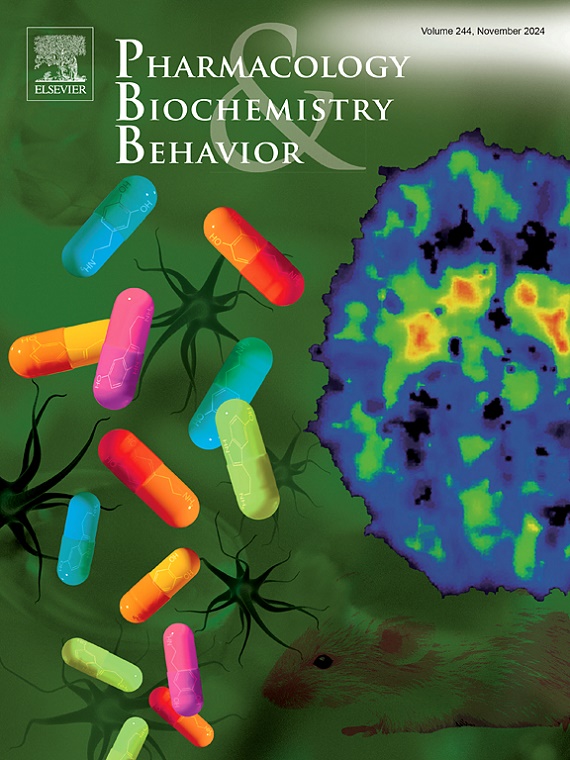Striatal dopamine D2, adenosine A2A and cannabinoid CB1 receptors balance as a target against non-cognitive symptoms in a mouse model of Alzheimer's disease
IF 3.3
3区 心理学
Q1 BEHAVIORAL SCIENCES
引用次数: 0
Abstract
Behavioral and psychological symptoms of dementia are almost ubiquitous in Alzheimer's disease (AD) but current therapies are not fully effective and safe. In this study, we aim to evaluate the role played by the interplay among striatal D2, adenosine A2A (A2AR) and cannabinoid CB1 (CB1R) receptors in some of these non-cognitive impairments in a well-established animal model of AD, the double transgenic APP/PS1 mice. Our results reveal that the alterations existing in the ratios between these three receptors significantly correlate with the sensorimotor gating and the social interaction impairments occurring in APP/PS1 mice at 12 months of age. Moreover, the pharmacological stimulation of A2AR and CB1R blunted the sensorimotor gating deficiencies in APP/PS1 mice. To note, we observed some age-dependent differences among male and female mice. In conclusion, the present study provides evidence for the contribution of an altered interplay between dopaminergic, adenosinergic and endocannabinoid systems in the sensorimotor gating deficits and social withdrawal occurring in AD and points to A2AR and CB1R as a potential target to reverse these non-cognitive symptoms in AD patients.
纹状体多巴胺D2、腺苷A2A和大麻素CB1受体平衡作为阿尔茨海默病小鼠模型非认知症状的靶点
痴呆症的行为和心理症状在阿尔茨海默病(AD)中几乎普遍存在,但目前的治疗方法并不完全有效和安全。在这项研究中,我们旨在评估纹状体D2、腺苷A2A (A2AR)和大麻素CB1 (CB1R)受体之间的相互作用在AD动物模型中所起的作用,即双转基因APP/PS1小鼠。我们的研究结果表明,这三种受体之间比例的改变与APP/PS1小鼠在12 月龄时发生的感觉运动门控和社会互动障碍显著相关。此外,A2AR和CB1R的药理刺激可以减弱APP/PS1小鼠的感觉运动门控缺陷。值得注意的是,我们观察到雄性和雌性小鼠之间存在一些年龄依赖性差异。总之,本研究为多巴胺能、腺苷能和内源性大麻素系统在阿尔茨海默病患者的感觉运动门控缺陷和社交退缩中相互作用的改变提供了证据,并指出A2AR和CB1R是逆转阿尔茨海默病患者这些非认知症状的潜在靶点。
本文章由计算机程序翻译,如有差异,请以英文原文为准。
求助全文
约1分钟内获得全文
求助全文
来源期刊
CiteScore
6.40
自引率
2.80%
发文量
122
审稿时长
38 days
期刊介绍:
Pharmacology Biochemistry & Behavior publishes original reports in the areas of pharmacology and biochemistry in which the primary emphasis and theoretical context are behavioral. Contributions may involve clinical, preclinical, or basic research. Purely biochemical or toxicology studies will not be published. Papers describing the behavioral effects of novel drugs in models of psychiatric, neurological and cognitive disorders, and central pain must include a positive control unless the paper is on a disease where such a drug is not available yet. Papers focusing on physiological processes (e.g., peripheral pain mechanisms, body temperature regulation, seizure activity) are not accepted as we would like to retain the focus of Pharmacology Biochemistry & Behavior on behavior and its interaction with the biochemistry and neurochemistry of the central nervous system. Papers describing the effects of plant materials are generally not considered, unless the active ingredients are studied, the extraction method is well described, the doses tested are known, and clear and definite experimental evidence on the mechanism of action of the active ingredients is provided.

 求助内容:
求助内容: 应助结果提醒方式:
应助结果提醒方式:


